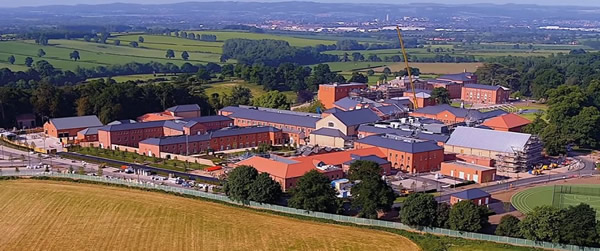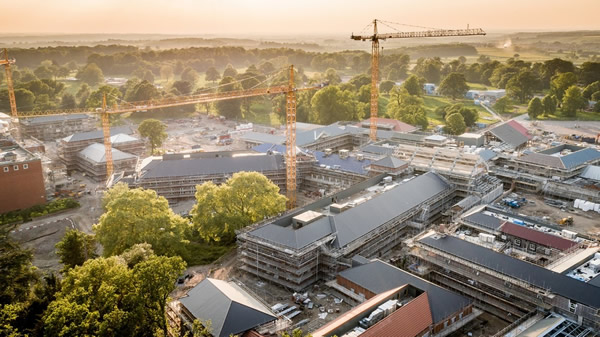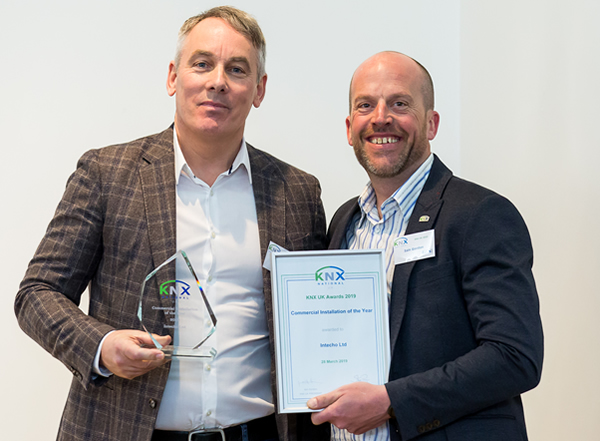
 By Ben Patterson and Paul Murphy, Intecho.
By Ben Patterson and Paul Murphy, Intecho.
The Defence National Rehabilitation Centre (DNRC) is a newly-constructed GBP300 million world-class medical facility that is located centrally on the Stanford Hall Estate, close to Loughborough, UK. Operated by the Ministry of Defence, the facility provides cutting-edge treatments to injured members of the armed forces for complex injuries, brain damage, musculoskeletal and spinal injury.
Construction of the DNRC started in July 2015 and the facility opened in 2018. The client was BS Stanford Ltd, the main contractor was Interserve Ltd and the M&E contractor was SES Engineering Services Ltd.

The brief
The designers specified a bio-dynamic lighting system for each of the 124 patient bedrooms. The aim was not only to save energy, but to provide a way of influencing patients’ circadian rhythms in order to improve well-being and aid recovery. Intecho Ltd was approached by SES Engineering Services as a partner, to provide this key electrical component, using DALI tuneable white LEDs.
Our original brief was quickly expanded to provide control of the fan coils, DALI lighting, C02 monitoring and windows throughout the vast estate, covering hundreds of areas within a multitude of buildings.

The solution
Intecho developed the bio-dynamic lighting profile and logic program using ABB, IPAS and Zennio components. The result is that the medical teams can either allow the automated tuneable white and room temperature to follow the pre-set 24-hour cycle, or allow individual patients to make adjustments locally via a touchscreen. The simple user interface in each room is provided by a Zennio touchscreen which also enables full control of the fan coil (for HVAC) and ‘standard’ non-biodynamic lighting. In some of the patient bedrooms, additional RGB DALI lighting was installed to provide colour therapy.
Throughout the morning, the system provides bright blue lighting (4000K) which encourages a healthy appetite, increases body temperature and heart rate, and leads to greater cognitive function. As night time approaches, a warmer (2700-3000K) lighting creates calm and lower hormone levels and further aids healing. These profiles alter the lighting continuously throughout the day and night to provide the correct colour temperature in patients’ bedrooms. In addition, by having warmer lighting, medical staff can complete rounds without disrupting patients’ sleep.
By integrating the fan coil, lighting, biodynamic lighting, C02 monitoring and motorised window controls onto the KNX bus, considerable project savings were made. SES was able to simplify the wiring throughout the project because a single bus network was used for many of the building control systems. This also reduced control and sensor duplication.
In total, the project uses over 2500 KNX devices provided by ABB, IPAS, Theben, Siemens and Zennio. The entire KNX system is connected by multiple IP interfaces to a site-wide Tridium Niagara Framework BMS system.
Experience from the project
Our involvement with this vast construction project totalled just over two years from initial conception through installation of the specialist lighting requirements and subsequent development of the more comprehensive brief to design and deliver a whole-site control strategy. The implementation and commissioning process ended late summer 2018. Since commissioning, no changes have been requested or necessary, and there are no current or ongoing issues.
As long-standing advocates of KNX, we are proud that this large and complex project stands as testament to the many benefits of designing projects using KNX. The main advantages we highlighted to our younger engineers were as follows.
• Early engagement within projects – this proved to be vital as it quickly allowed the M&E team to understand what we, as a company, and KNX could offer in order to better integrate services and avoid numerous standalone controls.
• Open protocol – the ability of our design team to select products best suited for the task without being constrained to a single manufacturer’s product basket benefits all, in particular the DNRC facility, which now has a system that can rely on ongoing product support from over 470 manufacturers.
Recognition
This project won Intecho the KNX UK Commercial Installer of the Year 2019 award. According to one of the judges, Julian Barkes, Director of Bemco Electrical Wholesaler and KNX UK Board Member, “Intecho’s award-winning project for the Defence National Rehabilitation Centre was stand out this year. Using KNX, Intecho has provided unsurpassed energy saving efficiencies for the centre and crucially, enabled a life-changing environment for the heroes and veterans who use the facility. The accomplishment of this project is testament to Ben and Paul’s technical experience, imagination and perseverance. They have raised the bar for KNX applications in the UK and deservedly for themselves.”

Conclusion
The KNX colour temperature solutions in patient bedrooms provide numerous health benefits, whilst allowing medical staff to complete rounds without disrupting patients’ sleep. Meanwhile, the wider KNX control of the huge sprawling site and the numerous buildings additionally offers significant energy savings and gives the facility management team an engineering platform for control and feedback of vital services. The BMS front end allows the onsite engineering team to monitor and control all of the KNX HVAC and core lighting systems.
Now that the project has been handed over, the onsite engineering team is able to manage the KNX system itself and is safe in the knowledge that the technology with which it has been provided is open standard and supported by multiple manufacturers.
Ben Patterson and Paul Murphy are both Directors and Co-founders of Intecho Limited, an award-winning provider of intelligent building technologies and home automation solutions.











